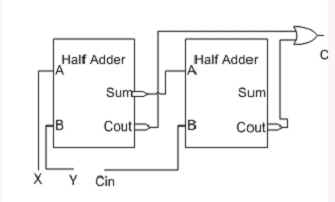
Using Components
Begin with the design of bottom units in VHDL
Save each unit in a separate VHDL file
Design the top unit next, placing bottom units as components
Name the project as the top unit and then compile
Example:
Using half adder as a component in the full adder
First design the half adder in file half_adder.vhd
Compile and simulate the design to make sure it works
properly.
=========Half Adder=========================
LIBRARY ieee;
USE ieee.std_logic_1164.all;
ENTITY half_adder IS
PORT (A, B : IN std_logic;
Sum, Cout : OUT std_logic);
END half_adder;
ARCHITECTURE myadd OF half_adder IS
BEGIN
Sum <= A xor B;
Cout <= A and B;
END myadd;
===========================================
Next, define a new file fulladder.vhd in the same directory
where half_adder.vhd resides. Use half adder as a component
in the full adder
First Let us draw the diagram in order to determine the requirements of the design

This circuit uses two instances of the component half adder. It also uses an OR gate which gets its inputs from internal lines. VHDL calls the internal lines as signals and the boxes shown as components. Now look the source code:
=============Full Adder=========================
LIBRARY ieee;
USE ieee.std_logic_1164.all;
ENTITY full_adder IS
PORT (A1, B1, Cin1 : IN std_logic;
Sum, Co1 : OUT std_logic);
END full_adder;
ARCHITECTURE myfulladd OF full_adder IS
signal Sum1,Cout1,Cout2:std_logic;
Component half_adder
port (A,B:in std_logic;
Sum, Cout:out std_logic);
end component;
BEGIN
H1:half_adder port map(A1,Cin1,Sum1,Cout1);
H2:half_adder port map(Sum1,B1,Sum,Cout2);
Co1 <= Cout1 or Cout2;
END myfulladd;
======================================================